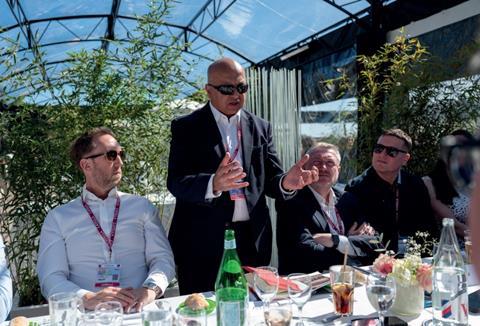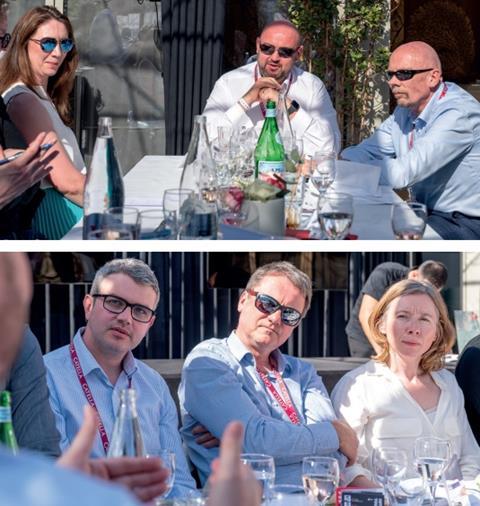How can the built environment sector revolutionise the way it delivers projects to meet our social, economic and environmental goals? Daniel Gayne reports
Few will disagree that construction is a sector ripe for transformation. Stuck in its old ways for years, many reckon the industry could be on the brink of major change, driven by new digital technologies, modular construction and the urgent need to meet the climate challenge.
But what is holding back this revolution in our way of doing business? And what will this brave new world of high productivity and low carbon look like?

In March, a group of experts from across the built environment gathered together at the annual Mipim international property conference in Cannes to discuss the obstacles to progress in the sector and what can be done to address them.
In a wide-ranging discussion, sponsored by contractor John Sisk & Son and hosted by ��ɫ����TV’s editorial director, Chloë McCulloch, the panel covered topics from the resourcing and expertise problem within the current planning system to MMC’s many false dawns and the industry’s lack of progress on net zero targets.
"Our focus has been on social value, so having more regional authorities would help that – and drive consistency and commitment around that return on investment."
Mark Robinson, Scape
Ajaz Shafi, chief operating officer UK at Sisk, began the conversation by outlining how his business has been “wrestling” with how to revolutionise project delivery and how the question has contributed to its new strategy, Breaking New Ground, which covers the firm’s approach in five key areas: people and culture, net zero, modern methods of construction, digital transformation and quality of earnings.
Sisk achieved net zero with offsetting two years ago and aims to be net zero without offsetting by 2030. McCulloch then moved the group on to their first topic – the spring Budget, which had been announced only a day earlier.
Impact of the Budget
“It was definitely better than the last budget,” said Mark Robinson, group chief executive of public procurement body Scape, to laughter from the table. He added that he was “interested to see” how the government’s plans for 12 new investment zones would pan out, particularly given the decline of the local enterprise partnerships.
“This continued push for regional combined authorities is something that we are very interested in, and I think it is a good move [because] it makes the public sector more efficient. Our focus has been on social value, so having more regional authorities would help that – and drive consistency and commitment around that return on investment,” he said.

Owen Michaelson, property board chairman of developer Godwin Group, said the chancellor’s announcement on full expensing of capital allowances for three years from April would also be a “big shift”, with a knock‑on effect for firms considering investment into the built environment.
But not everyone had positive words for chancellor Jeremy Hunt. Shafi said he was surprised the government did not try to adjust VAT for refurbishment – “I thought that would have been a great boost for the industry” – while James Blakey, planning director of build-to-rent developer Moda Living, said the budget had been “hugely disappointing” on housing delivery, reflecting the government’s “chaotic” approach to the issue.
“The government clearly are not serious about levelling up in relation to the way housing is delivered, both in terms of flexibility and choice, and we’re having to do it ourselves, despite government, not because of it.”
Give planners what they need
In his review of the budget, Blakey also noted that the planning system needs to be better resourced – a point which came up regularly throughout the discussion. Godwin Group co-founder Stuart Pratt agreed that while planning departments are “pretty competent”, the vast majority are “hideously under-resourced”.
You have to have a different mindset; one of a collaborative approach to how you engage people and get them on board early
Ger Hayes, John Sisk & Son
He added that the two-stage planning process adds complexity to the system by pitting politics against “design and detail” and urged other attendees to go to a planning application meeting to see what he meant.
Blakey countered an opinion that politics in planning was “a good thing” as long as councillors understand policy. “Resourcing is key, but education is the other piece,” he said. “Putting it very simply, there is a disconnect between the recommendation for approval and a councillor deciding to refuse it for a spurious reason.”
He added that the issue is becoming more difficult as an increasing number of minor parties and independent candidates are elected to councils.
Sisk’s strategy in brief: Breaking New Ground
Among the lessons of the last few years have been the need for a clear sense of purpose in the work we do.
John Sisk & Son sees its purpose as “creating places for future generations”, inspired by its founder’s sense of commitment to the communities in which he worked.
Breaking New Ground is Sisk’s response to the ever changing world around us – at its core, the strategy is focused on ensuring the company has the right people and culture in place to facilitate the accelerated mindset shift now required of our industry.
Meanwhile the firm will continue to operate as trusted partner as it embraces the challenges and opportunities associated with its net zero ambitions.
Sisk also continues to invest heavily in both its MMC and digital technology capability, recognising the critical enabling role they play in achieving more sustainable outcomes.
Lisa Deering, director at Glancy Nicholls, agreed that planning authorities need to be better resourced and pointed out that this would allow more early engagement and improve efficiency.
“The ability to get in and speak to planners, and have good face-time with them very early on, is key – because the sooner we can do that and work with the planning department to find the solution that works for everyone, the less time jobs are going to spend in planning and overall – it will improve efficiencies in the system,” she said.
Engaging early for net zero
Early engagement came up again in discussions around net zero, when Ger Hayes, Sisk’s managing director, UK South, pointed out its importance in delivering low-carbon projects.

“I think we need to have a more integrated approach to how we deliver these buildings. Sometimes the designs are so advanced by the time we get [specialists] involved, the amount of retro work you have to do is extensive… and then the solution isn’t the right solution for the project,” he said.
“I didn’t really see the need for the complex ecosystem that’s involved in delivering our projects. And it’s only when you sit down and you measure the data that you make really tangible differences to how you do it. But you have to have a different mindset; you have to have a collaborative approach to how you actually engage people and get them on board early.”
Shafi agreed, stating: “We need to look at the whole lifecycle cost. If we are invited to the table earlier, the cost aspect can be comprehensively studied and really understood – and we can bring in the supply chain expertise to make the right decisions.”
Atkins director Alan Jarvis said the technology necessary to deliver net zero goals is “tried and tested” but the lack of skills is making it difficult for supply chains to make full use of them.
He said: “We’ve got things like the apprenticeship levy, which just misses its targets completely because it is just not being spent – so how can we look at moving that a little bit quicker? Then we’ll start seeing knock-on effects in the supply chain.”
Michaelson said the construction industry is “beating itself up unnecessarily” over net zero, arguing that the process must begin with the client accepting higher cost.
“If you’re going to massively decarbonise and start using alternative materials, they cost more; it has to be paid for – it’s got to go up the chain,” he said.
The government’s role
Savills director Emma Anderson said the “jargon” around operational and embodied carbon can be confusing and defining net zero has to be “the starting point”.
Thomas Gardner, director at AHMM, agreed, saying: “There’s not a shared language or standard around measuring carbon, yet. We have price comparison websites; perhaps we need carbon comparison websites to serve the data so you can have a level playing field with this information.”
“We need to look at the whole lifecycle cost. If we are invited to the table earlier, the cost aspect can be comprehensively studied and really understood – and we can bring in the supply chain expertise to make the right decisions.”
Ajaz Shafi, John Sisk & Son
Scape’s Mark Robinson noted the government role in setting these terms, suggesting it should mandate a third criterion for sustainability on all government contracts, placing it on the same level as price and quality. “But you don’t want it to be subjective,” Michaelson pointed out, “because that then leads to greenwashing … the minute there is a double standard where it is a subjective test, somebody will undercut you and cut a corner.”
There was broad agreement around the table that the industry could adapt to stricter sustainability requirements, provided it was warned in advance. That way, said Pratt, “you can factor it into your pricing”.

The net zero discussion moved on to MMC, with Hayes encouraging a blended approach using kits of parts for elements of building such as MEP, facades and bathroom pods, with specialist firms supplying those products.
“I believed in the past that, as a main tier-one contractor, what we should do is buy all the smaller companies and integrate them into us. But those small companies are the best at running their businesses… I think that’s why if you have a platform, you can’t do it for everything; it would have to be a mixture,” he said.
Shafi agreed a kit of parts is more viable than the volumetric approach, saying: “It brings in that competition… two or three people can do that, rather than relying on one. You don’t want to be over-reliant on one system.”
"We train people in one skill, but if we had a multi-trained workforce that were educated in more than one skill, you’d be a lot more flexible and a lot more productive."
Stuart Syddell, Stace
Robinson said a lack of pipeline has been the main stumbling block for MMC so far, arguing that it discourages investment into expensive offsite facilities.
He once again emphasised the government’s role in correcting this, pointing out that while there has been “some adoption” in central government, the wider public sector is “not even giving it lip service”.
Pratt noted that in the residential market consumer tastes shift faster, making it harder to get a construction system based on standardisation and commissioning of mass-produced units to stick.
Deering said this simply requires developers and designers to build flexibility into their products, adding that the same applies to the question of aesthetics. “There’s little tweaks that can be made that just give you that variation that makes sense regionally,” she said. “It doesn’t need to be as complicated as people make it.”
Blakey agreed that developers “like to fiddle” with their product until the last minute and that modular building requires an entirely different mindset. “You need to settle it a year before and leave it to get manufactured.”
One thing to revolutionise the sector?
Asked what single thing might turbo-charge the construction sector, the table put forward a variety of options. Robinson suggested standardising profit margins across government contracts, while Alan Rodger, Sisk’s managing director, UK North, emphasised early engagement.
Shafi said risk needs to be shared more fairly, noting that at the moment “it gets pushed all the way down to the guy on the shovel”.
Stuart Syddell, a partner at Stace, suggested the industry needs to rethink the way it trains workers. “We train people in one skill, but if we had a multi-trained workforce that were educated in more than one skill, you’d be a lot more flexible and a lot more productive,” he said.
Bringing the discussion to a close, McCulloch returned to the topic of government and its failure to provide certainty to an industry in desperate need of it.
“It does seem that parts of the industry are working hard to do the right thing in terms of net zero and improving productivity, and there is a feeling central government is letting firms down in terms of a lack of policy and certainty,” she said. “The government needs to decide what the regulations are, decide what the standards are, and the industry will work to those.”
Round the table
Chair: Chloë McCulloch, editorial director, ��ɫ����TV
Emma Anderson, Emma Anderson, director – building consultancy, Savills
James Blakey, planning director, Moda Living
Lisa Deering, director, Glancy Nicholls
Simon Dingle, regional director UK North, John Sisk & Son
Thomas Gardner, director, AHMM
Ger Hayes, managing director UK South, John Sisk & Son
Alan Jarvie, director – infrastructure UK & Europe, Atkins
Owen Michaelson, property board chairman, Godwin Group
Stuart Pratt, board director and co-founder, Godwin Group
Mark Robinson, group chief executive, Scape
Alan Rodger, managing director UK North, John Sisk & Son
Ajaz Shafi, chief operating officer UK, John Sisk & Son
Stuart Syddell, partner, Stace
Lynne Wellington, head of business development UK South, John Sisk & Son

























